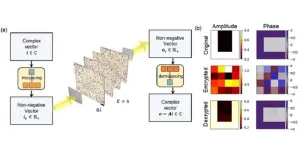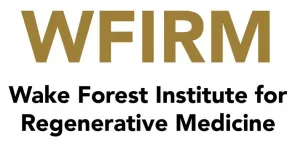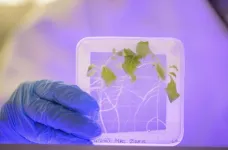(Press-News.org) State-of-the-art neural networks heavily rely on linear operations, such as matrix-vector multiplications and convolutions. While dedicated processors like GPUs and TPUs exist for these operations, they have limitations in terms of power consumption and bandwidth. Optics is better suited for such operations because of its inherent parallelism, large bandwidth, and computation speed.
Diffractive deep neural networks (D2NN), also known as diffractive networks, constitute an emerging optical computing architecture. These task-specific networks are constructed from spatially engineered thin surfaces and can passively perform computational tasks at speed-of-light propagation through an ultrathin volume. The spatial features of these diffractive surfaces are learned through a one-time design process, and the optimized surfaces are then fabricated to create the physical hardware of the diffractive optical network.
A recent publication in Advanced Photonics Nexus by a team led by Aydogan Ozcan, Chancellor’s Professor and the Volgenau Chair for Engineering Innovation at UCLA, introduces a method to perform complex-valued linear operations with diffractive networks under spatially incoherent illumination. Previous research by the same group showed that diffractive networks with sufficient degrees of freedom can perform arbitrary complex-valued linear transformations with spatially coherent light. However, under spatially incoherent light, these networks can perform arbitrary linear transformations of input optical intensities if the matrix elements defining the transformation are real and non-negative. Given that spatially incoherent illumination sources are more prevalent and easier to access, there is a growing need for spatially incoherent diffractive processors to handle data beyond just non-negative values.
By incorporating preprocessing and postprocessing steps to represent complex numbers by a set of non-negative real numbers, UCLA researchers have extended the processing power of spatially incoherent diffractive networks to the domain of complex numbers. They demonstrated that such incoherent diffractive processors can be designed to perform an arbitrary complex-valued linear transformation with negligible error if there is a sufficient number of optimizable phase features within the diffractive design, which needs to scale up with the dimensions of the input and output complex vector spaces.
The researchers showcased the practical application of their novel scheme through the encryption and decryption of complex-valued images using spatially incoherent diffractive networks. Beyond visual image encryption, these processors hold potential applications in various fields, such as in autonomous vehicles for ultrafast and low-power processing of natural scenes. The adaptability of spatially incoherent diffractive processors to handle data beyond non-negative values makes them valuable in diverse scenarios.
For details, see the original Gold Open Access article by Xilin Yang, Md Sadman Sakib Rahman, Bijie Bai, Jingxi Li, and Aydogan Ozcan, “Complex-valued universal linear transformations and image encryption using spatially incoherent diffractive networks,” Adv. Photon. Nexus 3(1) 016010 (2024), doi 10.1117/1.APN.3.1.016010.
END
Optical computing boost with diffractive network advance
UCLA researchers extend the processing power of optical computing via spatially incoherent diffractive networks
2024-01-22
ELSE PRESS RELEASES FROM THIS DATE:
Wake Forest Institute for Regenerative Medicine (WFIRM) to lead $40 Million initiative for AFIRM Consortium
2024-01-22
Winston Salem, NC – January 22, 2024 - The Wake Forest Institute for Regenerative Medicine, part of Wake Forest University School of Medicine, has been selected to lead the Armed Forces Institute of Regenerative Medicine (AFIRM) Consortium. The project - a $40 million, five year-long award from the Defense Health Agency (DHA) - will focus on taking regenerative medicine solutions for battlefield injuries to the next level, and ultimately to the general public.
Regenerative medicine is a science that takes advantage of the body's natural abilities to restore or replace damaged tissue and organs. WFIRM has managed two prior AFIRM consortia since ...
Argonne National Laboratory flexes capabilities with receipt of four nuclear innovation vouchers
2024-01-22
A decade that began with a global shutdown is a third of the way done. Its finale — a major deadline for reducing U.S. carbon emissions to slow climate change — approaches at the usual clip. With the decade’s halfway mark in view, the U.S. Department of Energy (DOE) Gateway for Accelerated Innovation in Nuclear (GAIN) awarded seven new vouchers to companies and national laboratories working to develop and commercialize clean nuclear energy projects. Nuclear energy is considered central to efforts to minimize carbon emissions and still reliably meet rising ...
Strategy to boost prostate cancer treatment efficacy devised at Rutgers Health
2024-01-22
Rutgers researchers can predict which patients will benefit from a popular prostate cancer drug – and have devised a strategy that may make the treatment work longer.
“This work should help doctors know which patients’ prostate cancers will and won’t respond to the androgen deprivation therapy enzalutamide, which can slow prostate cancer growth by disrupting androgen receptor signaling,” said Antonina Mitrofanova, associate professor of Biomedical and Health Informatics, associate dean for research at the Rutgers School of Health Professions, researcher at Rutgers Cancer ...
Salad in space? New study says it's not a healthy choice
2024-01-22
Lettuce and other leafy green vegetables are part of a healthy, balanced diet — even for astronauts on a mission.
It’s been more than three years since the National Aeronautics and Space Administration made space-grown lettuce an item on the menu for astronauts aboard the International Space Station. Alongside their space diet staples of flour tortillas and powdered coffee, astronauts can munch on a salad, grown from control chambers aboard the ISS that account for the ideal temperature, amount of water and light ...
Sexual minority young people in Canada more likely to experience harmful police contact
2024-01-22
Toronto, ON – While there has been much public scrutiny and research on police interactions and violence towards sexual minorities in the United States, there is a gap in the current literature on how sexual minorities fare with law enforcement contact in Canada. A new study published in the Annals of Epidemiology aims to fill this research gap by examining the relationship between sexual orientation and experiences with police contact, including intrusion and harassment from the police, in Canada.
Among a sample of 940 adolescents and young adults across Canada, the study found that the prevalence of police contact was highest among persons ...
University Hospitals OBGYN and urologist Joseph Welles Henderson, MD, named InterStim™ Center of Excellence
2024-01-22
CLEVELAND -- Joseph Welles Henderson, MD, of University Hospitals has been named an InterStim™ Center of Excellence by Medtronic (NYSE: MDT), the world’s largest medical device manufacturer. The designation is awarded to caregivers who have demonstrated particular expertise in the use of the InterStim™ system to treat overactive bladder, as well as non-obstructive urinary retention and chronic fecal incontinence.
Dr. Henderson is an OBGYN and urologist, and specializes in female pelvic medicine and reconstruction ...
Thinning of brain region may signal dementia risk 5-10 years before symptoms
2024-01-22
SAN ANTONIO, Jan. 22, 2024 — A ribbon of brain tissue called cortical gray matter grows thinner in people who go on to develop dementia, and this appears to be an accurate biomarker of the disease five to 10 years before symptoms appear, researchers from The University of Texas Health Science Center at San Antonio (also called UT Health San Antonio) reported.
The researchers, working with colleagues from The University of California, Davis, and Boston University, conducted an MRI brain imaging study published ...
Zeng researching techniques for achieving supply chain security for the Internet of Things
2024-01-22
Qiang Zeng, Associate Professor, Computer Science, received funding for the project: "Towards Lifetime Supply Chain Security for Internet of Things: Testing an Update Before Trusting It."
The global Internet of Things (IoT) market size is expected to rise substantially by 2029. IoT devices are manufactured by various companies around the world, and thus, should not be trusted by default. Zeng aims to ensure lifetime supply chain security of IoT devices. To attain this objective, he is proposing to test an IoT device and every firmware update through ...
Arafin conducting research aimed at securing chiplet-based semiconductor manufacturing from untrusted supply chains
2024-01-22
Md Tanvir Arafin, Assistant Professor, Cybersecurity Engineering, received funding for the project: "Securing Chiplet-based Semiconductor Manufacturing from Untrusted Supply Chains."
Monolithic integrated circuit (IC) design is reaching the physical limit to accommodate the ever-increasing demand of cramming more transistors in a chip. To address this, novel design primitives that move from monolithic design practices to heterogeneous integration of IC primitives in a 2.5 or 3D structure have emerged. ...
Good and bad news for people with low back pain
2024-01-22
Low back pain is a major cause of disability around the globe, with more than 570 million people affected. In the United States alone, health care spending on low back pain was $134.5 billion between 1996 and 2016, and costs are increasing.
"The good news is that most episodes of back pain recover, and this is the case even if you have already had back pain for a couple of months," University of South Australia Professor Lorimer Moseley says.
"The bad news is that once you have had back pain for more than a few months, the chance ...
LAST 30 PRESS RELEASES:
Oldest modern shark mega-predator swam off Australia during the age of dinosaurs
Scientists unveil mechanism behind greener ammonia production
Sharper, straighter, stiffer, stronger: Male green hermit hummingbirds have bills evolved for fighting
Nationwide awards honor local students and school leaders championing heart, brain health
Epigenetic changes regulate gene expression, but what regulates epigenetics?
Nasal drops fight brain tumors noninvasively
Okayama University of Science Ranked in the “THE World University Rankings 2026” for the Second Consecutive Year
New study looks at (rainforest) tea leaves to predict fate of tropical forests
When trade routes shift, so do clouds: Florida State University researchers uncover ripple effects of new global shipping regulations
Kennesaw State assistant professor receives grant to improve shelf life of peptide- and protein-based drugs
Current heart attack screening tools are not optimal and fail to identify half the people who are at risk
LJI scientists discover how T cells transform to defend our organs
Brain circuit controlling compulsive behavior mapped
Atoms passing through walls: Quantum tunneling of hydrogen within palladium crystal
Observing quantum footballs blown up by laser kicks
Immune cells ‘caught in the act’ could spur earlier detection and prevention of Type 1 Diabetes
New membrane sets record for separating hydrogen from CO2
Recharging the powerhouse of the cell
University of Minnesota research finds reducing inflammation may protect against early AMD-like vision loss
A mulching film that protects plants without pesticides or plastics
New study highlights key findings on lung cancer surveillance rates
Uniform reference system for lightweight construction methods
Improve diet and increase physical activity at the same time to limit weight gain, study suggests
A surprising insight may put a charge into faster muscle injury repair
Scientists uncover how COVID-19 variants outsmart the immune system
Some children’s tantrums can be seen in the brain, new study finds
Development of 1-Wh-class stacked lithium-air cells
UVA, military researchers seek better ways to identify, treat blast-related brain injuries
AMS Science Preview: Railways and cyclones; pinned clouds; weather warnings in wartime
Scientists identify a molecular switch to a painful side effect of chemotherapy
[Press-News.org] Optical computing boost with diffractive network advanceUCLA researchers extend the processing power of optical computing via spatially incoherent diffractive networks




